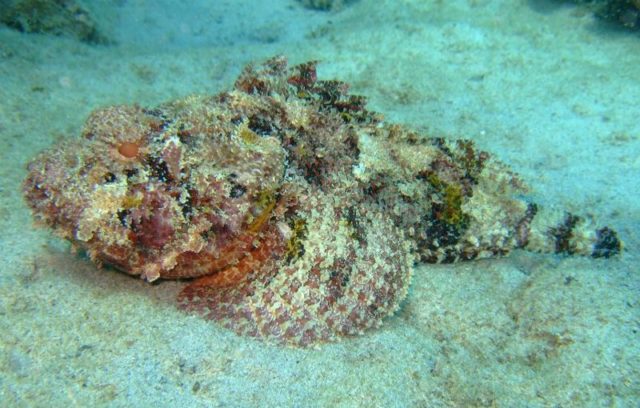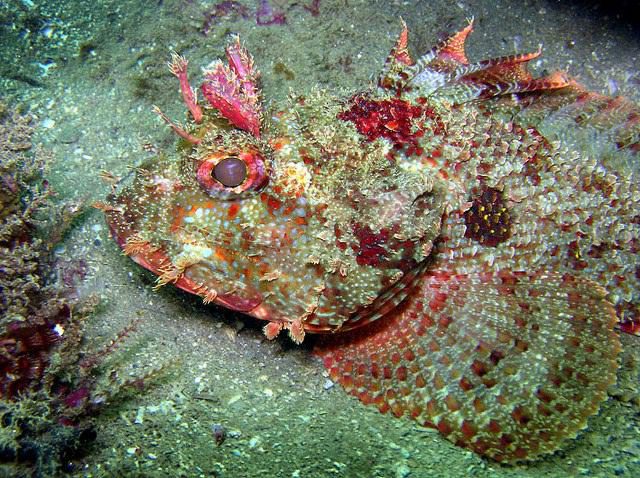Scorpionfish: A Family of Venomous Fish
If you think that a scorpionfish is a combination of a scorpion and a fish, then somehow, you got it this time. But before we proceed, this combination has nothing to do with their appearance where the looks of a scorpion and a fish are combined together. No. Rather, it has something to do with the defensive and offensive characteristics of a scorpion and the bodily features of a fish.
Highly Venomous
Similar to the true land scorpions, all species of scorpionfish are highly venomous. While a true scorpion’s venom glands are located at the tip of their tail called telson, the venom glands of a scorpionfish are scattered all over the spines of their fins. This means that if you accidentally touch a scorpionfish, in any part or side of their body, the chances of being stung is relatively high. Just in case you get stung by a scorpionfish, the first thing to expect is pain. And I tell you, it is very painful, as I myself has already been stung by a scorpionfish.
Let’s take my case where i was stung in the hand. As a result of exhaustion from a commercial night dive while salvaging a ton of concrete structure, I accidentally drop my hand to the sand. While my hand is slowly dropping down, I notice and realize that there was this highly camouflage fish lying motionless in the sand. The bad news: my hand is in a collision course with that fish. With exhaustion prevailing, I was not able to retract my hand and I touch the scorpionfish. I immediately took off my gloves and saw that one spine successfully penetrated. While I was inspecting the very small wound, the size of a needle prick, I was surprise that I felt no pain. But after a few seconds, this indescribable pain started to set in beginning at the very point of penetration. A few minutes later, the pain rose up to my elbow which eventually ended in my clavicle near the armpit. It was very painful. Lucky for me, the venom was not transmitted in its full potency as the spine penetration was shallow and the gloves i wore was proven to be an effective body armor. The pain was gone in a few hours and I was only left behind with a swollen finger.
But if I wasn’t able to wear gloves causing the spines to penetrate deeply, then I would have suffered a different fate. Divers who get minor sting may suffer from fever, headache, swelling in the infected area, abdominal pain, nausea and vomiting. In extreme cases, divers may suffer difficulty in breathing, muscle twitching, seizure and paralysis.
It’s not only divers who are stung by scorpionfish. Beach-goers are among the victims of a scorpionfish sting. We have to remember that scorpionfish are shallow bottom dwellers and the area where beach lovers walk are often the favorite place for scorpionfish to hung-out.
First aid treatment for a scorpionfish venom is letting the infected area soak in hot water. You need to clean the infected area from foreign objects like sand, mud or dirt. Other than that, do not attempt to do additional treatment to the patient and the best thing to do is seek immediate medical attention.
With all these information, you should be very careful every time you set your foot on the seafloor. Having this knowledge is a great way in preventing accidents to happen and knowing the different species of scorpionfish can further prevent any untoward incident that may happen in the future. But we have to remind you, the picture below may look different on the actual ocean scenario as scorpionfish are known to be masters of camouflage and uses the environment to conceal itself.
Species of Scorpionfish in Cocos Island
Peruvian Scorpionfish (Scorpaena afuerae)
Max. Length: 35 centimeters
Length at 1st Maturity: 21.2 centimeters
a value:
b value:
Depth Range: 1 – 100 meters (3 – 300 feet)
Frequency: Abundant in the reefs of the Eastern Pacific Ocean
Diving in Cocos island doesn’t give you a problem in spotting a Peruvian scorpionfish as they often go out in the open and does not use the defensive mechanism of camouflage. Aside from not hiding, you can easily identify a Peruvian scorpionfish through its bright body color. Generally, they are colored red with stripes and spots that resembles like an abstract.
Aside from venom-enriched fin spines, other venomous spines can be found in a Peruvian scorpionfish. They are mostly located on the head portion where 3 rows of small spines can be erected if the animal gets threatened.
Rainbow Scorpionfish (Scorpaenodes xyris)
Max. Length: 15 centimeters
Length at 1st Maturity: 10 centimeters
a value: 0.01670
b value: 2.925
Depth Range: 1 – 30 meters (3 – 100 feet)
Frequency: Abundant in the reefs of the Eastern Pacific Ocean
Similar to a Peruvian scorpionfish, the rainbow scorpionfish is another brightly colored venomous fish that do not engage in camouflage. They are usually seen out lying motionless on top or under a rock. Being motionless is their own way of doing the ambush technique of feeding where their favorite meal includes small fish and shrimp.
This brown-red colored fish that has 5 irregular dark bars on the side of its body and a prominent black spot on the gills is further equipped with additional poisonous protrusions especially behind the eye region.
The problem most people encounter with a rainbow scorpionfish is not in the water. Most of the stinging incidence for this particular species happens in the market. When they are freshly chilled, they look like small groupers and once you touch the spines, the venom is still potent even if the animal is already dead.
Player Scorpionfish (Scorpaena histrio)
Max. Length: 26 centimeters
Length at 1st Maturity: 16.3 centimeters
a value:
b value:
Depth Range: 5 – 150 meters (15 – 450 feet)
Frequency: Abundant in the reefs of the Eastern Pacific Ocean
Now we go to the species of scorpionfish that are hard to spot. While the brightness of its body color still stands out, a player scorpionfish now uses camouflage to conceal itself.
While its brown colored body that is mottled with red still stands out, spotting a player scorpionfish will now be hard as it blends with the color of the sand as part of their camouflage mechanism. In case you were able to see a live specimen in Cocos island, you will observe that what is obviously visible are the protruding venomous spines. These spines usually take the color of its body which is generally red-brown.
Stone Scorpionfish (Scorpaena mystes)
Other name: Pacific Spotted Scorpionfish
Max. Length: 45.7 centimeters
Length at 1st Maturity: 26.8 centimeters
a value:
b value:
Depth Range: 0 – 30 meters (0 – 100 feet)
Frequency: Abundant in the reefs of the Eastern Pacific Ocean
Looking for a stone scorpionfish in Cocos island will really put your visual sighting to the test. Their large, bulging and heavily camouflage body that is mostly lying motionless in the sand will tell a non-trained eye that this is a stone rather than a scorpionfish.
But if you will really take a closer look, you will notice that this non-moving structure has a big head and spiny eyes. This scorpionfish has the ability to partly burrow and shower its body with sand by the flapping of its pelvic fins. But once this fish moves and the sand covering is taken off, you can now clearly see their true body color which is a multiple combination of black, grey, brown, red and green.
A Newly Discovered Scorpionfish Endemic to Cocos island
Based from a single specimen retrieved from the waters of Cocos island, a new species of scorpionfish was discovered by a Japanese ichthyologist. The Cocos Scorpionfish (Scorpaena cocosensis) is a small-sized scorpionfish that is generally colored red-orange. The discovery further revealed that a Cocos Scorpionfish is equipped with eight dorsal spines that are all enriched with venom ready to be disposed at any moment someone touches it.
While this discovery was only based from a single specimen, scientist are now hoping to promote further studies to fully understand the dynamics of this fish and to prove if this newly discovered scorpionfish is endemic to Cocos Island.
Before we end this article, allow us to inform you that the purpose of writing this article is not to scare you. In fact, there are more accidents happening on the road as compared to the ocean. But rather, our primary aim is to equip you with the knowledge that you can use someday in preventing a possible painful accident.
References
Fishbase: www.fishbase.org
BioOne: www.bioone.org
Costa Rica – Scuba: www.scuba.cr
PLEASE DO NO IMITATE WHAT IS DEPICTED IN THE VIDEO. Video courtesy from HammerInVA
You also might like these:
Cocos Island Liveaboard Trips for 2019
Due to high demand of liveaboard trips to Cocos island, as early as this year, we are publishing the 2019 trips for you to choose your preferred schedule and prepare for the ultimate diving adventure of your life. Reserve your seat to Cocos Island as they are selling like hotcakes. Schedule of Liveaboard Trip to […]























